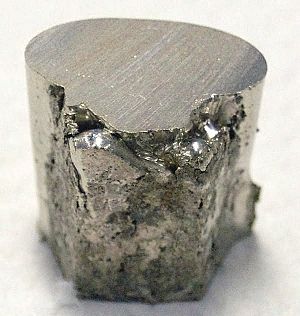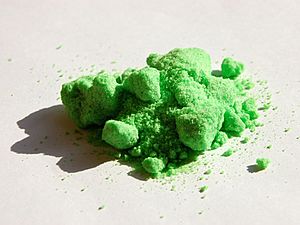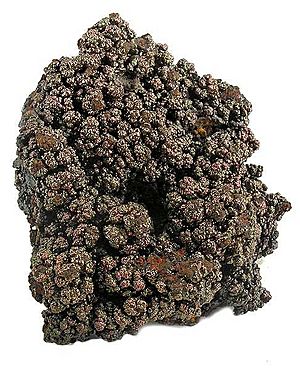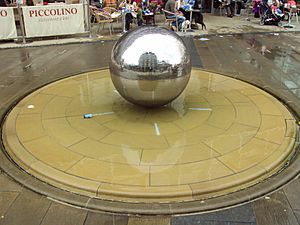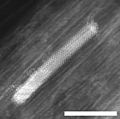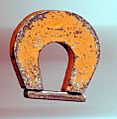Nickel facts for kids
Nickel (chemical symbol Ni) is an element. It has an atomic number of 28 and an atomic mass of about 58.69amu. It has 28 protons. It is a transition metal.
Contents
Properties
Physical properties
Nickel is a silver-white metal. It is easily polished (made shiny). It is magnetic. It is not magnetic when heated above 355 °C (671 °F). It is not soft like many other metals. It can be stretched into wires easily. It is not radioactive.
Chemical properties
Nickel is not a reactive metal. It dissolves slowly in acids. It does not rust like iron. It makes a thin coating of nickel(II) oxide which stops more corrosion. Aluminium does a similar thing.
Chemical compounds
Nickel is found in two oxidation states: +2, nickel(II); and +3, nickel(III). Nickel(II) is more common. Nickel in its +2 oxidation state is green. Nickel(II) chloride is a common +2 oxidation state compound. Nickel(II) oxide is normally dark green, but sometimes it is gray. This is because some of the nickel is in the +3 oxidation state (nickel(III). Nickel(III) compounds are oxidizing agents. They also are grayish. Nickel compounds can be green, blue, gray, or black.
- Nickel(II) compounds
Nickel(II) compounds are not highly reactive. They are normally green or blue. They are toxic and irritate skin. Some of them are carcinogens.
- Nickel(II) carbonate, green
- Nickel(II) chloride, greenish
- Nickel(II) hydroxide, light green
- Nickel(II) nitrate, greenish
- Nickel(II) oxide, gray or light green
- Nickel(II) sulfate, blue-green
- Nickel(III) compounds
Nickel(III) compounds are black or gray.
Isotopes
The isotopes of nickel range in atomic weight from 48Ni to 78Ni. Nickel that is found in nature is made up of five stable isotopes; 58Ni, 60Ni, 61Ni, 62Ni and 64Ni.
At least 26 radioisotopes of nickel have been found. The most stable radioisotope is 59Ni which has a half-life of 76,000 years. Nickel also has one meta state.
History
Nickel was found when an ore that looked like copper did not make copper metal. Later it was found that the ore actually had a new metal, called nickel. Nickel was isolated as a metal and classified as a chemical element by Axel Fredrik Cronstedt in 1751. At first, the copper colored nickel ore was the only source. Later, it was made as a byproduct of cobalt blue making.
Occurrence
Nickel is normally found in minerals, and not as a metal in the ground. Sometimes meteorites have nickel and iron metal in them. The most common nickel mineral is pentlandite. Most of the nickel on Earth is thought to be in the Earth's outer and inner cores. There are sulfidic and lateritic nickel ores. Philippines mines the most nickel. Other major mining countries are Russia, Canada and Australia.
Preparation
Nickel is found in both laterite and sulfide ores. They are heated to melt them and concentrate them. They are also separated by oils. Nickel is made from its sulfide by heating it in air. This oxidizes the sulfide to sulfur dioxide, leaving liquid nickel behind. This nickel is not yet pure and not ready for use.
Pure nickel with a nickel content greater than 99% is made in an electrolytic process. In this process, the nickel is dissolved in bath of sulfuric acid. When the pure nickel sticks to cathodes hanging into the bath, the impurities remain in the sulfuric acid or at the bottom of the bath. These impurities are very interesting, as they can contain precious metals.
Uses
Sixty-eight percent of all nickel produced is used to make stainless steel. Nickel is also used in nichrome, a name for a nickel-chromium alloy, and other alloys. Nickel is used in magnets. Nickel is used in special expensive alloys called superalloys.
Nickel sulphate is used in rechargeable batteries. A lithium ion battery contains up to 15% of nickel while the lithium content is less than 1%. A nickel cadmium battery also uses nickel. Nickel compounds are also used to electroplate nickel on items. Nickel and some of its compounds are also used as a catalyst. Nickel is used in stainless steel. It is also used in some nonferrous alloys. It is used in electroplating.
Nickel is used to make many products like stainless steel, alnico magnet, coinage, rechargeable batteries, electric guitar strings, microphone capsules and plating on plumbing fixtures. It is used as a green tint in glass.
Nickel foam is used in gas diffusion electrodes for alkaline fuel cells.
Nickel and its alloys are used as catalysts for hydrogenation reactions. Nickel is used as a binder in the cemented tungsten carbide.
63Ni is used in krytron devices as a beta particle emitter to make ionization by the keep-alive electrode more reliable. Raney nickel is used for hydrogenation of unsaturated oils to make margarine.
Concentrations in Surface Sea water
Nickel concentrations vary over the surface layer of the worlds’ oceans. Nickel concentrations correlate with nutrient concentrations because it can be up taken by photosynthesizing organisms, such as diatoms. Nickel is then remineralized at depth from biogenic material. However, there is regional variability. In general, dissolved Nickel concentrations are rarely below 1.5-2.0 nmol/kg of seawater, usually in nutrient-deplete areas since it follows a similar profile. For example, there are generally lower concentrations in the northern hemisphere of the Atlantic Ocean, with the lowest Nickel concentration being 1.7 nanomol (nmol)/ kg of seawater. This could be related to greater Nickel uptake by nitrogen fixers and a high influence of aeolian iron concentrations. Photosynthesizing organisms’ uptake the Nickel with an uptake in iron because iron stimulates nutrient in photosynthesizing organisms. Furthermore, in nutrient-rich eastern boundary currents, Nickel concentrations average 3.5 nmol/kg of seawater. North Atlantic surface waters (Equator to 40⁰) from 0-100 meters range from 2.06 to 2.52 nmol/kg of seawater. In the North Atlantic, Nickel concentrations increase in concentration with depth from 0-500m range at 3.13 to 3.61 nmol/kg of sea water.
In the Southern Ocean, Nickel concentrations from 0-500m range from 5.67 nmol/kg of seawater to 6.51 nmol/kg of seawater. Southern oceans tend to have greater concentrations mainly due to the absence of a thermocline, which encourages intense mixing through storms and internal wave action. In the northeast Pacific Ocean from 0-500m, Nickel concentrations range from 5.54 nmol/kg of seawater to 6.63 nmol/kg of seawater, as there is a region of productivity there. In the non-upwelling, open-ocean of the North Pacific, concentrations of Nickel are between 1.0 and 2.0 (nmol) per kilogram of seawater (kg). Meanwhile, in equatorial upwelling surface zones of the Eastern Pacific, concentrations of Nickel average 3.0 nmol/kg of seawater. Upwelling brings nutrients to the surface waters, including various Nickel ion species.
Safety
Nickel can irritate skin. That is why jewelry that releases nickel ions is bad for some people. Some nickel salts are carcinogens. Nickel is not as toxic as other metals such as mercury but it is still toxic.
Related pages
- Nickel compounds
| Periodic table | |||||||||||||||||||||||||||||||||||||||||
|---|---|---|---|---|---|---|---|---|---|---|---|---|---|---|---|---|---|---|---|---|---|---|---|---|---|---|---|---|---|---|---|---|---|---|---|---|---|---|---|---|---|
| H | He | ||||||||||||||||||||||||||||||||||||||||
| Li | Be | B | C | N | O | F | Ne | ||||||||||||||||||||||||||||||||||
| Na | Mg | Al | Si | P | S | Cl | Ar | ||||||||||||||||||||||||||||||||||
| K | Ca | Sc | Ti | V | Cr | Mn | Fe | Co | Ni | Cu | Zn | Ga | Ge | As | Se | Br | Kr | ||||||||||||||||||||||||
| Rb | Sr | Y | Zr | Nb | Mo | Tc | Ru | Rh | Pd | Ag | Cd | In | Sn | Sb | Te | I | Xe | ||||||||||||||||||||||||
| Cs | Ba | La | Ce | Pr | Nd | Pm | Sm | Eu | Gd | Tb | Dy | Ho | Er | Tm | Yb | Lu | Hf | Ta | W | Re | Os | Ir | Pt | Au | Hg | Tl | Pb | Bi | Po | At | Rn | ||||||||||
| Fr | Ra | Ac | Th | Pa | U | Np | Pu | Am | Cm | Bk | Cf | Es | Fm | Md | No | Lr | Rf | Db | Sg | Bh | Hs | Mt | Ds | Rg | Cn | Uut | Fl | Uup | Lv | Uus | Uuo | ||||||||||
|
|||||||||||||||||||||||||||||||||||||||||
Images for kids
-
Electron micrograph of a Ni nanocrystal inside a single wall carbon nanotube; scale bar 5 nm.
-
Electrolytically refined nickel nodule, with green, crystallized nickel-electrolyte salts visible in the pores.
-
A "horseshoe magnet" made of alnico nickel alloy.
See also
 In Spanish: Níquel para niños
In Spanish: Níquel para niños


